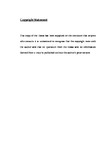Allelopathic Potential of the Invasive Alien Himalayan Balsam (Impatiens glandulifera Royle)
| dc.contributor.supervisor | Brown, Murray | |
| dc.contributor.author | Smith, Owen Peter | |
| dc.contributor.other | Faculty of Science and Engineering | en_US |
| dc.date.accessioned | 2013-08-05T10:33:29Z | |
| dc.date.available | 2013-08-05T10:33:29Z | |
| dc.date.issued | 2013 | |
| dc.date.issued | 2013 | |
| dc.identifier | 10038185 | en_US |
| dc.identifier.uri | http://hdl.handle.net/10026.1/1592 | |
| dc.description.abstract |
Investigations were carried out into the allelopathic potential of the invasive alien annual Himalayan Balsam (Impatiens glandulifera Royle) using a series of bioassays, including ones developed or adapted for this study. They were evaluated for their suitability to detect three of the four main modes of allelochemical release, namely leaching, exudation and decomposition. Assays which involved the measurement of lettuce radicles and hypocotyls gave reliable results and allowed a range of different Impatiens material, both living and dead, to be assessed and ranked according to the allelopathic effects demonstrated. Attempts were made to isolate resource competition from allelopathy using separately grown but connected donor and receiver plants and a density dependent design where single I. glandulifera plants were grown in pots with variable numbers of receiver plants. Results proved inconclusive. Initial experiments showed that the allelopathic potential of I. glandulifera varied according to the organ from which the material was derived. Pods, leaves and stems produced the greatest inhibition of lettuce seedlings. Effects on germination were not significant at most of the concentrations tested. Live roots of I. glandulifera plants produced pronounced orange staining of the agar into which they were placed and showed clear evidence of distance dependent inhibition of lettuce radicles. Effects were limited to growth rather than germination of the test plants. Germinating I. glandulifera seeds caused a significant inhibition of lettuce radicle elongation when the two species were grown together in an agar medium. The inhibitory effects increased significantly with increasing exposure time. Increasing I. glandulifera seedling number also produced significant reductions in lettuce radicle length. Dormant seeds, by contrast, stimulated growth. Dead seeds did not produce significant changes to the growth of the test plants. When rhizosphere soil was gathered from pot grown I. glandulifera plants, the results were mixed. Initial samples inhibited growth, whereas those collected from dying plants over a period of weeks stimulated growth. Further experimentation is required before the indications of allelopathic interactions demonstrated here can be applied to the behaviour of wild populations of I. glandulifera. | en_US |
| dc.description.sponsorship | Seale-Hayne Educational Trust, Tamar Valley Sustainable Development Fund | en_US |
| dc.language.iso | en | en_US |
| dc.publisher | University of Plymouth | en_US |
| dc.subject | Impatiens glandulifera | |
| dc.subject | Himalayan Balsam | |
| dc.subject | Invasive Alien Species | |
| dc.subject | Allelopathy | en_US |
| dc.title | Allelopathic Potential of the Invasive Alien Himalayan Balsam (Impatiens glandulifera Royle) | en_US |
| dc.type | Thesis | |
| plymouth.version | Full version | en_US |
| dc.identifier.doi | http://dx.doi.org/10.24382/4307 |
Files in this item
This item appears in the following Collection(s)
-
01 Research Theses Main Collection
Research Theses Main


